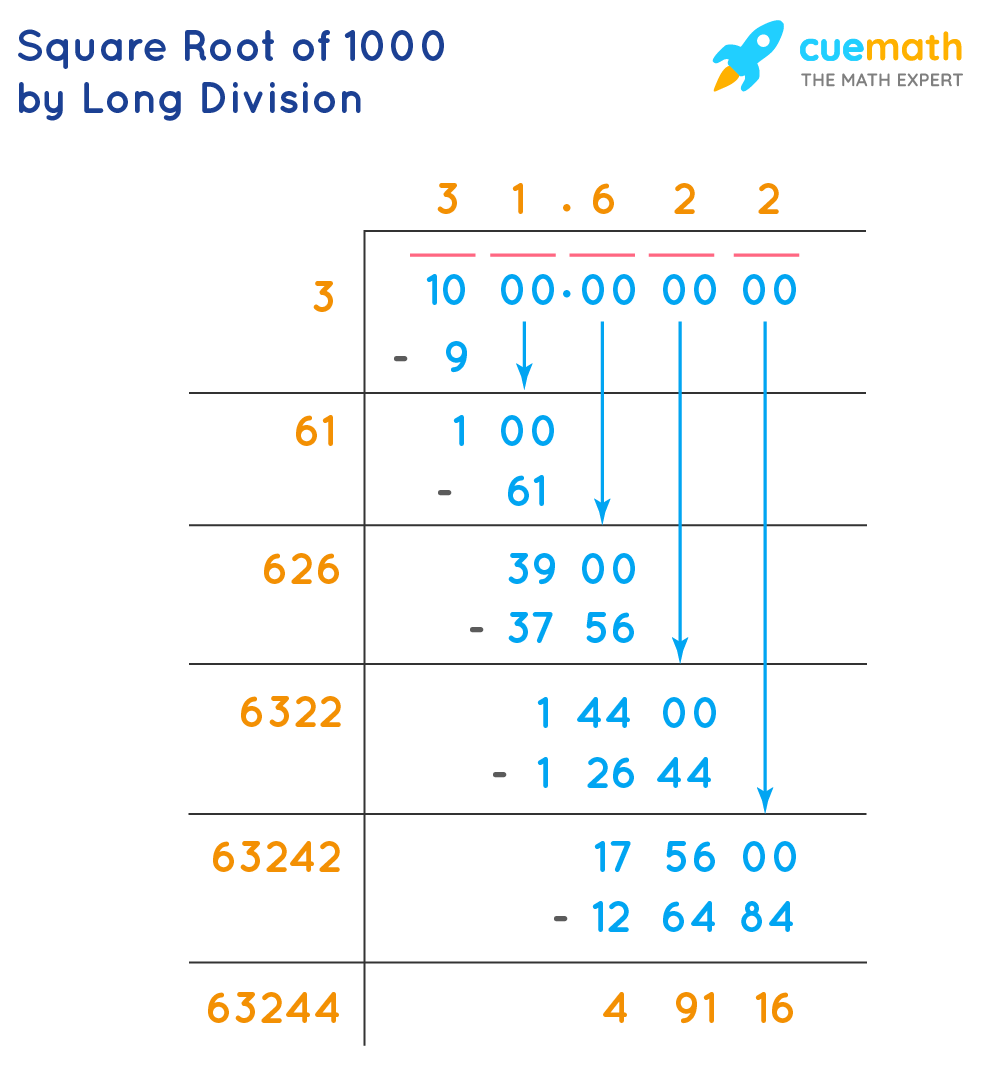Square Root of 1000
Square root of a number can be obtained by finding which when multiplied by itself, gives the original number. In this lesson, you will learn the square root of 1000 and how to find square root of 1000.
- Square Root of 1000: √1000 = 31.622
- Square of 1000: 1000000
| 1. | What Is the Square Root of 1000? |
| 2. | Is Square Root of 1000 Rational or Irrational? |
| 3. | How to Find the Square Root of 1000 |
| 4. | Important Notes on Square Root of 1000 |
| 5. | FAQs on Square Root of 1000 |
What Is the Square Root of 1000?
We know that addition has an inverse operation as subtraction and multiplication has an inverse operation as division.Similarly, calculating the square root of a number is the inverse operation of squaring the number. The square root of 1000 is the number that gets multiplied to itself to give the number 1000. So, we need to think of a number whose square is 1000.

Is the Square Root of 1000 Rational or Irrational?
A rational number is a number that can be expressed in the form of p/q. A number that is not a rational number is called an irrational number. Non-terminating decimals, which have repeated numbers after the decimal point are rational numbers. Now, let us look at the square root of 1000
The decimal representation of √1000 is 31.6227766
Do you think the decimal part stops after 31.6227766? No, it is never-ending, therefore. it is a non-terminating decimal with non-repeating numbers. The number 31.6227766⋯can't be written in the p/q form.
So, the square root of 1000 is an irrational number.
How to Find the Square Root of 1000?
We will discuss two methods of finding the square root of 1000
- Simplifying the radical of the numbers that are perfect squares.
- Long division method for perfect and non-perfect squares.
Therefore, √1000 can be simplified further as √1000 =√(2 × 2 × 2 × 5 × 5 × 5) = 10√10
Thus, we have expressed the square root of 1000 in the simplest radical form as 10√10. So, √1000 = 10√10
The value of the square root of 1000 by long division method consists of the following steps:
- Step 1: Starting from the right, we will pair up the digits by putting a bar above them.
- Step 2: Find a number which when multiplied to itself gives the product less than or equal to 10. As square of 3 is 9, which is less than 10 hence, the divisor and quotient is 3 and the remainder obtained is 1.
- Step 3: Now double the quotient and place it as the next divisor. The number which is on the one's place is filled with the largest possible digit, such that when the new divisor is multiplied with the new quotient, the product is less than or equal to the dividend. Solve and write the remainder. Repeat this process to get the number of decimal places you want.

Important Notes
- The Square root is the inverse operation of squaring.
- Square root of 1000 can be expressed as √1000 or 10001/2
- We can find the square root of 1000 using the radical form and the long division method.
Explore Square roots using illustrations and interactive examples
Solved Examples
-
Example 1: Edwin wants to put a shutter on his square window. He has two shutters. One has an area of 10000 sqft and the other has an area of 1000 sqft. Can you help him find the length of these shutters so that he can select the suitable one for his window?
Solution
To find the side of each shutter, we will have to find the square root of 10000 and 1000
The square root of 10000 is √10000 = 100
The square root of 1000 is √1000 = 10√10 = 31.622So, the side lengths of the shutters are 100 inches and 10√10 inches respectively.
-
Example 2: What is the Lucy wants to tile the floor of her bathroom. Each tile has an area of 1000 square inches. What is the length of one side of the tile?
Solution
By finding the square root of the area, we can find the side length of the tile.
Using the property of square roots, we have √1000= √100 × √10 = 10 × √10 = 100
So, the side length of the tile is 100 inches.

FAQs on Square Root of 1000
1. What is the square root of 1000?
The square root of 1000 is 10√10.
2. What number squared exactly equals 1000?
The number 10√101010 when squared, equals 1000.
3. What is the estimated value of √1000?
The approximate value of √1000 is 31.
4. What is the perfect square nearest to square root of 1000?
Nearest perfect square to 1000 is 1024 which is the square of 32.
visual curriculum
